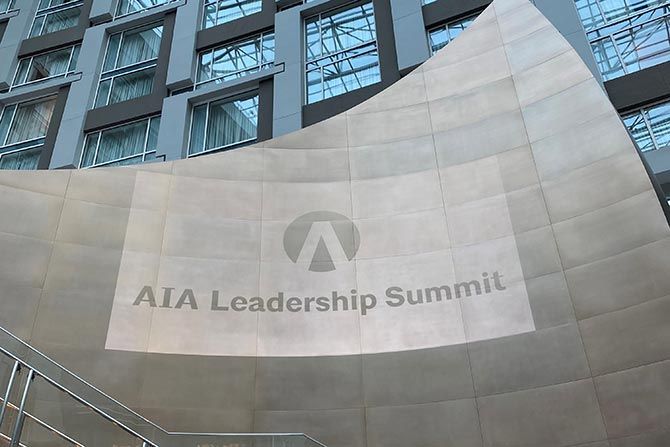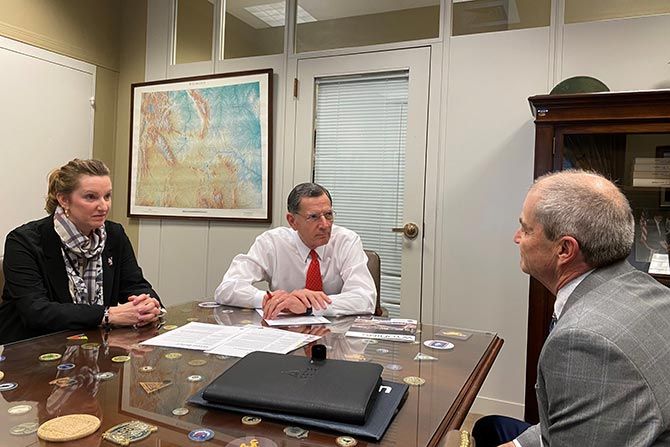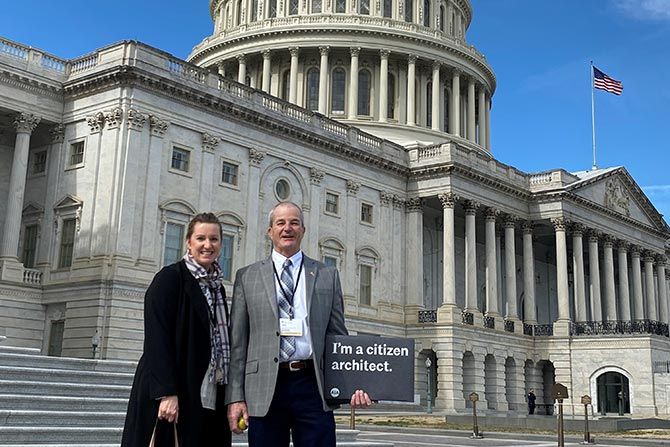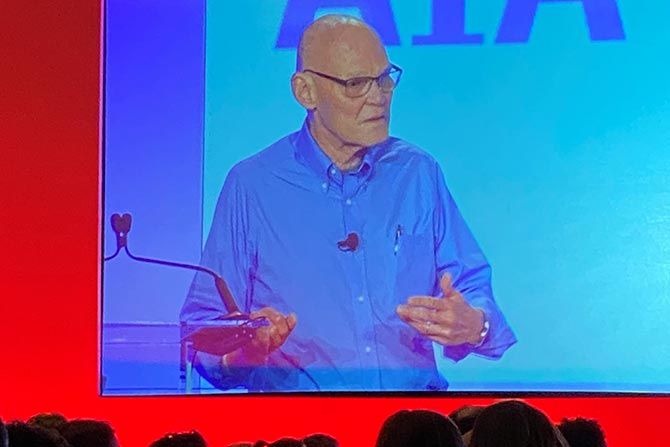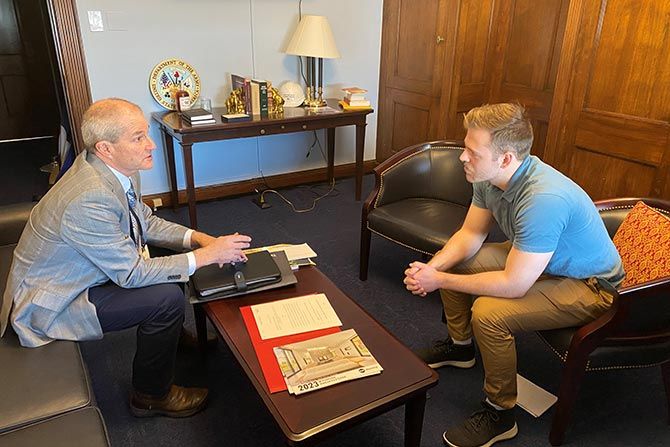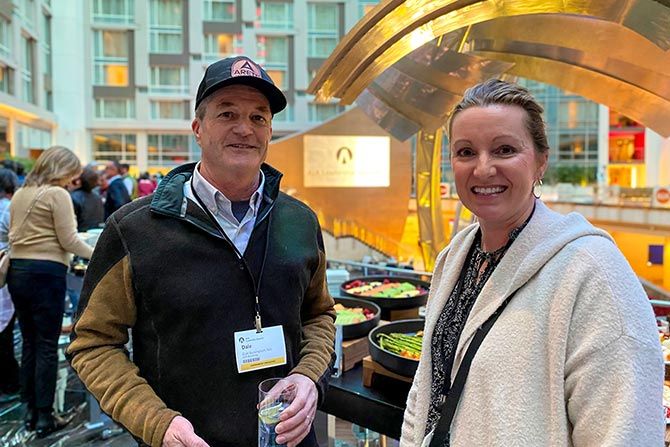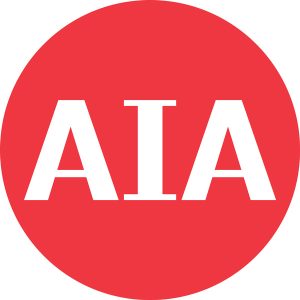After two years of virtual gatherings, AIA’s premier chapter leadership training event returned to Washington, D.C., Feb. 14-17, 2023, with a new name and an exceptional program. Dale Buckingham, AIA and Susan Menghini attended the AIA Leadership Summit 2023 (formerly the Grassroots and Leadership Conference) for four days of vital leadership training, keynotes, networking, Hill Day and much more.
The conference included how multigenerational trends change architecture, practical business knowledge through concurrent sessions on chapter management, operations and leadership, networking with hundreds of peers, and Capitol Hill visits to influence policy and engage with Members of Congress. Highlights include:
- This year’s theme, Architecture’s Generations at Work, focused on building bridges to create a better world and a stronger profession, skills you can apply to every facet of your professional life.
- AIA Leadership Summit is always one of AIA’s best-attended events. This year, reconnecting in person made it even more special.
- The leadership of architects is critical in demonstrating the power of design to address society’s most pressing challenges, from climate action to racial and social justice to the pandemic. We took note of the discussion on how to advocate for the broader purposes of architecture through civic activism and the role of architects in making time for civic advocacy in their communities.
The opening general session, titled Citizen Architect, began on the afternoon of Tuesday, February 14 with keynote James Carville. James is an American political consultant, author and occasional actor who has strategized for candidates for public office in the United States and in at least 23 nations abroad.
Following the keynote presenter was a panel discussion on keeping the momentum of advocacy throughout the year. Involved citizens must advocate for their priority issues on a continual basis. The session explored ways to build lasting relationships with our elected officials, generate interest for our causes and collaborate with partners. The panelists Lakisha Woods, Kimberly Dowdell, Emily Grandstaff-Rice and Kevin Holland covered how AIA’s advocacy programs can add to your federal, state and local campaigns.
AIA Lobby Day is one component of this year’s AIA Leadership Summit, with more than 400 architect members who attended meetings with their members of Congress. As professionals and constituents, AIA members are advocating for two bipartisan pieces of legislation that benefit communities and their inhabitants.
In support of AIA’s Federal Issues agenda, Dale and Susan discussed with Senator John Barrasso, Senator Cynthia Lummis’ Legislative Assistant, Holt Edwards and Representative Harriet Hageman’s Legislative Assistant, James Leavitt, the Democracy in Design Act to ensure that communities across the country maintain a voice in the design of federal buildings consistent with their preferences, culture, topographies and design traditions. We also reviewed for the Resilient AMERICA Act, which would make significant changes to the federal government’s ability to prepare communities for future natural disasters. The bill would accomplish this by increasing federal funding for pre-disaster mitigation through FEMA’s Building Resilient Infrastructure and Communities (BRIC) program.
On the Thursday following our Hill visits, we joined in on the opening plenary session with AIA Leadership on designing the future of the profession, a discussion on issues impacting the built environment and architects.
The remainder of Thursday morning included breakout sessions on chapter management that included engaging multiple generations, generational tech divide, the power of mentoring, guide to equitable hiring, utilizing social media, know/sell your organization and non-dues revenue programming and more.
One session attended was by Kim Lear with Inlay, a generational expert, writer and strategist who provided insights and understanding of generational trends and discovered how valuable employees of all ages are changing the workforce. While generational diversity brings various experiences and perspectives to the workplace, each generation’s differing needs and values must be addressed to build a high-performing organization. The increasing diversity in groups resulting from the mix of generations and cultures is driving a shift toward more complexity in mentoring, managing and leading, affecting processes and workforce expectations.
Another session attended was about the power of mentoring and preparing emerging professionals. Mentorship is a vital component of an architect’s career. Whether you are in the process of earning your license or an emerging professional, mentorship is important for the mentor and the mentee, providing value to both and the firm. At the end of the day, everyone has the same goal in mind, looking to make their best contribution on the journey while being happy and fulfilled for themselves and their surroundings. We shared our experiences on partnerships that have helped shape career paths.
Continued breakout sessions on Thursday included a session on the importance of good governance. Reviewing and improving the governance structure provides a range of benefits from reducing failure risks to improving chapter financial and operational performance. The session focused on the benefits of a good governance reviewed and how to do an effective review that delivers actionable results. Another session included how to recruit, select and hire staff for AIA chapters to broaden opportunities and create lasting organizational development. The session provided leaders with insights on how to design and implement an executive search that will attract a diverse talent pool and give all qualified candidates an equal opportunity. Successful member engagement leads to increased retention and renewal rates. Members are looking for value and engagement. The more personalized experiences, the better.
The Thursday afternoon general session, titled Together in the Sandbox, was led by Vancouver, WA resident from Martin and Downs Association Consulting Solutions, Ginger Downs, CAE, an Association Management Consultant of 35 years, who gave a great presentation to end the day on chapter management and leadership takeaways. She reviewed the importance of the partnership of staff and leadership. Her Ferris wheel description of members (spokes) and staff (hub) was a way to identify that you can’t do one without the other. She noted the board should focus on three primary roles: stewardship, oversight and accountability.
Ginger Downs is a recognized realtor association executive and a national speaker and facilitator who regularly conducts leadership and association executive training programs. She chaired many National Association of Realtors (NAR) executive committees and work groups. She also served on key committees, including its executive, finance, strategic planning, communications and diversity committees. Ms. Downs has presented at numerous NAR leadership summits. For more than 10 years, she has presented at the association’s new executive training and was consistently ranked the #1 presenter. She has been a guest speaker at national meetings of the Women’s Counsel of Realtors, the Institute of Real Estate Management and the National Association of Apartments. She was the featured keynote speaker at the Realtor Association Professional Development Directors Summit in 2018. She was an instructor and content developer for the NAR’s L.E.A.D. program. As a partner of Martin & Downs (M & D) Association Consulting Solutions in May 2018, she has provided services and training to over 100 associations, including planning, leadership training, general facilitation, governance reviews, executive search and much more.
The Thursday prior to the evening reception, Susan attended the CACE (Council for Architectural Component Executives) meeting to hear about updates from AIA Trust, AIA Member Resources, Lakisha Woods, EVP/CEO, and Kevin Watkins, Membership and Component Engagement.
The final day of the AIA Leadership Summit included a final session of chapter management that included topics on civic engagement, component partnership with AIA, leadership development for success and resource development for volunteers and staff. The session attended on citizen architects explored the impact architects can make in creating livable, healthy, sustainable and quality-designed environments in their communities. The panelists shared thoughts on creating a professional culture where civic engagement is valued, the expertise of architects is valued, and chapter members become trusted advisors to elected officials.
In closing, the keynote addressed Leadership in Changing Times. Shelia C. Johnson, Co-founder of Black Entertainment Television (BET) and CEO of Salamander Hotels & Resorts, Entrepreneur and philanthropist, provided the closing session. We heard the personal stories of how Ms. Johnson reimagined and reframed challenges and solutions to become a successful change leader.
The Leadership Summit provides great networking opportunities with other practitioners and staff. In conversations with others from Hawaii to Virginia and many states in between, a common discussion revolved around engaging and mentoring young professionals to carry the torch of our profession into the next decades. Our challenge in Wyoming is not unique. Throughout the nation, we are searching for the best strategies for older professionals to catch up with the technology and younger professionals to fully gain experiential knowledge available from those who have gone before them.
We thank the board of directors for sending us to Washington, D.C., for the leadership conference and encourage others to attend next year.
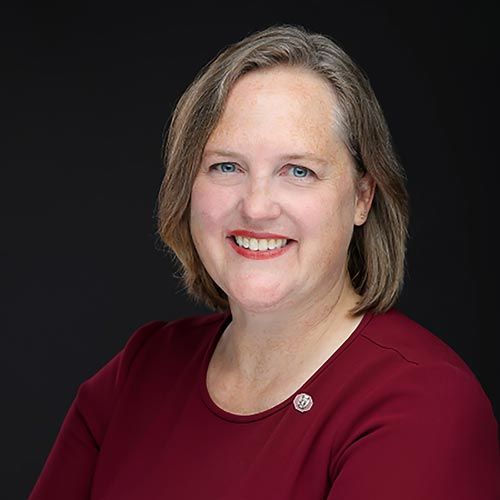
AIA 2023 President Emily Grandstaff-Rice, FAIA

Kim Lear, Inlay
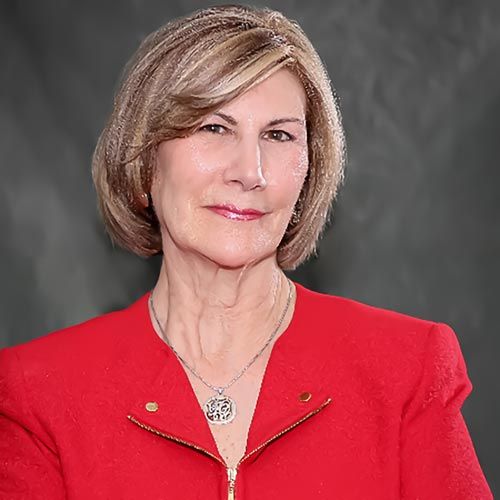
Ginger Downs, CAE
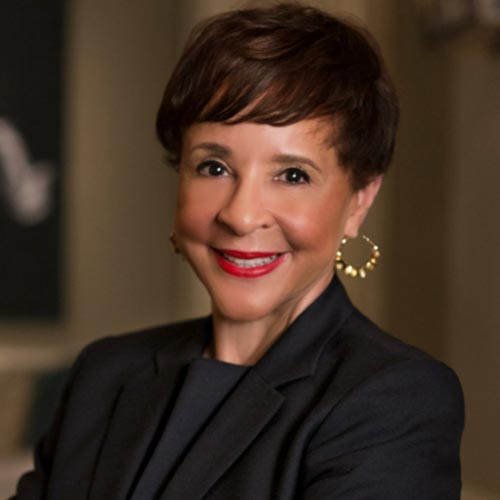
Shelia C. Johnson
